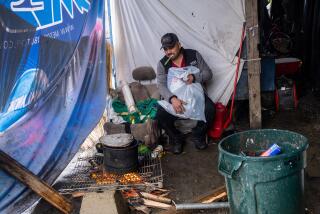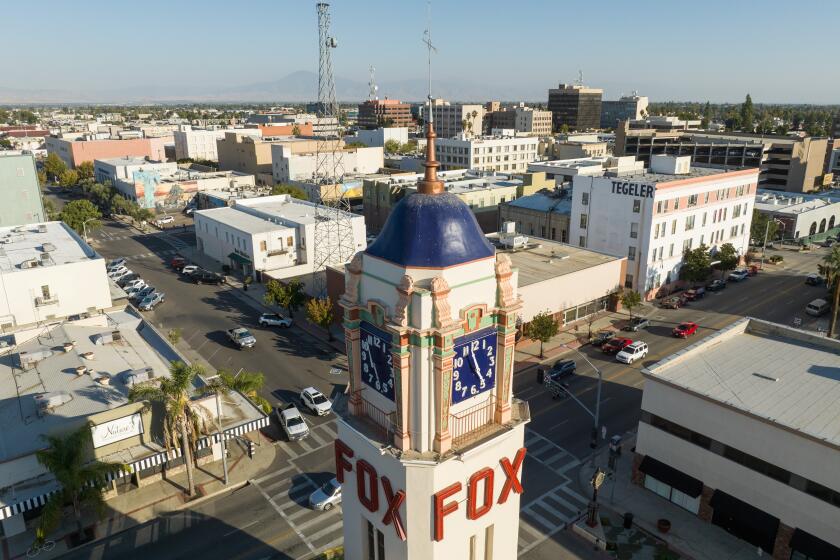For Underground Pipeline, Risk Is Relative
When the last length of pipe is laid next year, the $170-million Pacific Pipeline will pump 130,000 barrels of heated crude oil each day through the heart of Los Angeles.
The project will cut a route through one of the most seismically active regions in the state. It will bisect the most densely populated minority communities in the city and run only 30 feet below an aqueduct that carries 75% of Los Angeles’ water supply.
That may sound like a recipe for disaster, but an extensive state environmental report calls the pipeline a safer alternative to hauling the crude oil in trucks, tankers and trains.
In this case, “safer” is a relative term. Modern “risk analysis” involves a quantitative, but not precise, evaluation of probabilities--and, as in this case, frequently boils down to a search for the lesser of two perils.
A city analysis predicts that the pipeline will have at least four leaks and two ruptures creating spills of up to 11,000 barrels of crude oil over the next 50 years. But such a risk is considered nominal compared to those posed by older pipelines and other modes of oil transportation.
The 132-mile line will stretch from Kern County through the San Fernando Valley and Northeast and South Los Angeles to refineries in Wilmington. But it is not the biggest or longest pipeline in the city. The county is already crisscrossed by 2,000 miles of petroleum pipelines, many of them larger than the 20-inch diameter Pacific Pipeline.
The key difference is that the Pacific line is the only new crude oil pipeline route in the Los Angeles Basin in the last 35 years, thus providing modern safety improvements not available in previous lines.
“As with any industry, the technology that is here today is better than it was in prior years,” said Nancy Wolfe, chief of pipeline safety for the State Fire Marshal, the agency that oversees pipeline safety statewide.
The safety aspects of the line gained new significance last week when the Los Angeles City Council accepted a legal settlement that cleared the way for construction of the line.
For seven years, the city has battled the project, arguing that the line poses a significant threat to highly populated minority communities in the San Fernando Valley and in Northeast Los Angeles.
But the Pacific Pipeline owners have repeatedly whipped the city in courtrooms throughout the state, forcing the council to approve a settlement to end all legal challenges to the project.
The settlement was a huge victory for Burbank-based Pacific Pipeline System, which plans to begin construction within the city boundaries in mid-June and complete it in early 1998.
As part of the settlement, Pacific Pipeline System agreed to provide the city with 72 lines of fiber optics along the route and 150 computers for schools, libraries and community centers throughout Los Angeles.
But the amenities did not appease Councilman Richard Alarcon, who represents communities in the northeast Valley that the line will traverse. He said he continues to oppose the line, arguing that it unfairly imposes the risks of a rupture on poor minority residents.
“I felt all along that it is wrong to force a pipeline on a community,” he said.
*
An analysis by the city’s Environmental Affairs Department says that 92% of the census tracts involved have a population density higher than Los Angeles County’s average.
In addition, the analysis says, 89% of the census tracts have a higher percentage of minorities than the city’s average.
While the city argued that the pipeline owners should have considered alternative routes, Pacific Pipeline System representatives insisted that the line was not intended to target minority communities. They said it was designed to follow major transportation routes, such as the Southern Pacific Railroad and the Golden State Freeway.
Moreover, pipelines are crucial to the state and regional economies.
California is the fourth-largest oil-producing state in the nation and transports 87% of its crude oil to refineries through pipelines, which are roughly half as expensive as any other means of moving oil.
It is for that reason that Pacific Pipeline System plans to invest about $170 million to make the line a reality.
Once the project is completed, the line’s owners have promised to reduce the use of oil-carrying trucks, trains and tankers, which generate more pollution and pose a statistically greater accident risk. The project is expected to reduce the need for 49 truck trips per day, one rail car per day and 88 marine tankers per year, according to a city Department of Transportation study.
According to that study, such a reduction would avoid 13 tanker truck accidents and a resulting seven deaths over the next 50 years; eliminate the release of 2,400 barrels of oil, 11 deaths and 25 injuries caused by train accidents; and forestall marine tanker spills of up to 250,000 barrels causing up to $10 billion in damage.
A 1993 State Fire Marshal study on pipeline safety found that pipelines are 300 times less likely to cause a fatal accident than tanker trucks and 40 times less likely to cause a death than an oil-carrying train.
But pipelines are not completely risk free.
“Nothing is risk free,” said Wolfe. “You can’t get into your car on the highway without facing some risk.”
During the next 50 years, the city’s Transportation Department predicts, the Pacific Pipeline will rupture or leak six times, spilling up to 11,000 barrels of crude oil near “sensitive receptors,” such as playgrounds, schools or parks.
By comparison, the state had 514 leaks or ruptures along 7,800 miles of pipeline between 1981 and 1990, according to the fire marshal study. The average spill size was 408 barrels, costing an average of $141,000 in damage.
For that reason, Pacific Pipeline System has been required by state law to purchase $100 million in insurance.
But the project has an advantage over other pipelines: It will use stronger construction material and modern leak detection devices.
The state study found that most pipeline accidents are due to external corrosion, which is more common among older pipes that operate at high temperatures.
“Pipelines constructed before 1940 had a leak incident rate roughly 20 times higher than pipelines constructed in the 1980s,” the study said.
But such numbers do not impress Laura Lake, a former UCLA political science professor who specializes in environmental policy issues. She is more concerned about the increased capacity that the line provides to oil refineries in the area.
Despite the promises that the Pacific Pipeline will reduce the number of trucks, trains and tankers to refineries, Lake said she does not believe that the line will be used to simply maintain the current capacity at area refineries.
She made the same argument when she fought Mobil Oil’s 1991 plans to replace a 92-mile line from Bakersfield to Torrance. “They don’t make that kind of capital outlay for a steady stream of production,” she said. “They want to expand.”
Instead of providing more capacity, Lake said, city officials should be cracking down on the pollution generated by refineries.
“This is a fragile ecosystem and the people living in it are hurting,” she said. “It hurts the young and the old the most.”
Southern California’s geology also includes many active faults. A state environmental study of the pipeline route found 10 faults along which seven serious quakes occurred over the past 150 years.
In fact, the line will parallel an existing crude oil pipeline that burst into flames in Mission Hills after the Northridge earthquake, creating a nightmarish explosion and fire that injured one man, destroyed a house, damaged three other homes and burned 17 vehicles.
*
The fire marshal’s study predicted up to 29 oil ruptures or leaks statewide due to earthquakes in the next 30 years.
But pipeline supporters say they have taken that into account and plan to install a fiber optics monitoring system that will shut down the line in the event of a magnitude 6.0 or greater quake. The system also will include 44 block valves that can close off the flow of oil, even during the power failures that often accompany quakes.
Another key concern has been the potential for a leak near a water source. Along the route, the line will pass 75 streams or waterways and four ground water basins.
But what concerned the Los Angeles City Council most was the line’s passage beneath the city’s main aqueduct in Sylmar, which carries 75% of the city’s water supply.
“We cannot move forward with a pipeline that threatens 75% of our water supply,” Alarcon said in January when he urged his council colleagues to fight the project.
After meeting with the city’s Department of Water and Power, Pacific Pipeline System agreed to pay for $1 million in additional improvements for the pipeline crossing at the aqueduct, including an extra steel liner around the line. It also agreed to bury the line 30 feet below the water, much deeper than was originally proposed.
“We have a letter from the State Fire Marshal that says we not only meet the federal safety standards but we exceed them,” said Jim Shamas, Pacific Pipeline System’s vice president.
Despite millions of dollars in safety improvements, supporters and opponents acknowledge that spills are unavoidable.
In approving an environmental report for the Pacific Pipeline project, the California Public Utilities Commission said: “The only way to avoid these impacts is to stop shipping oil.”
(BEGIN TEXT OF INFOBOX / INFOGRAPHIC)
Pipeline Dispute
Construction in Los Angeles of the $170-million Pacific Pipeline is expected to begin in June. The 132-mile line will run from Kern County to refineries in Wilmington. Supporters say the project will create jobs and reduce the need for oil-carrying trucks, trains and tankers.
Pipeline Facts
Length of pipeline: 132 miles
Depth: Ranges from 5 to 7 feet.
Capacity: 2,000 barrels per mile.
Volume: 130,000 barrels of crude oil daily.
Cost: $170 million
Time for one barrel to travel from Kern County to El Sequndo/ Wilmington: 2 1/2 days.
Speed of oil flow: 2 to 3 mph.
Pipeline owners: Chevron, Texaco and the Anschutz Co.
Source: Pacific Pipeline System Inc., Pacific Pipeline Project environmental impact statement; Researched by STEPHANIE STASSEL and HUGO MARTIN / Los Angeles Times
More to Read
Start your day right
Sign up for Essential California for news, features and recommendations from the L.A. Times and beyond in your inbox six days a week.
You may occasionally receive promotional content from the Los Angeles Times.







